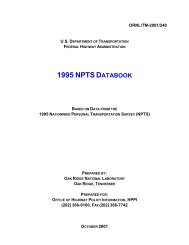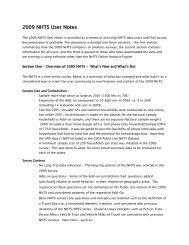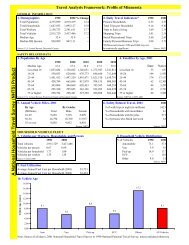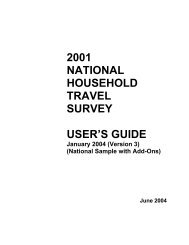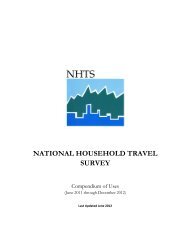Uses of National Household Travel Survey Data in - NHTS Home ...
Uses of National Household Travel Survey Data in - NHTS Home ...
Uses of National Household Travel Survey Data in - NHTS Home ...
You also want an ePaper? Increase the reach of your titles
YUMPU automatically turns print PDFs into web optimized ePapers that Google loves.
Special Population Groups<br />
Urban Sprawl and Miles Driven Daily by Teenagers <strong>in</strong> the United States<br />
Authors:<br />
Trowbridge, Matthew John; McDonald, Noreen C<br />
American Journal <strong>of</strong> Preventive Medic<strong>in</strong>e Issue: 3<br />
3/1/2008<br />
Abstract:<br />
The association <strong>of</strong> urban sprawl with <strong>in</strong>creased automobile reliance and daily mileage is well established<br />
among adults. However, sprawl's specific impact on teen driv<strong>in</strong>g exposure is unknown. Teen driver<br />
fatality rates per mile driven are significantly higher than adults, mak<strong>in</strong>g the identification <strong>of</strong><br />
environmental <strong>in</strong>fluences on travel behavior particularly important <strong>in</strong> this age group. Driv<strong>in</strong>g and<br />
demographic data for 4528 teens (weighted=10.5 million) aged 16-19 years were obta<strong>in</strong>ed from the 2001<br />
<strong>National</strong> <strong>Household</strong> Transportation <strong>Survey</strong> (<strong>NHTS</strong>). County-level sprawl was measured us<strong>in</strong>g an <strong>in</strong>dex<br />
developed by Ew<strong>in</strong>g et al. The association between daily miles driven by teens and sprawl, controll<strong>in</strong>g for<br />
demographic characteristics, was modeled us<strong>in</strong>g ord<strong>in</strong>al logistic regression. The predicted probability <strong>of</strong><br />
driv<strong>in</strong>g >20 miles <strong>in</strong> counties with vary<strong>in</strong>g degrees <strong>of</strong> sprawl also was calculated. Of the surveyed teens,<br />
48% did not drive, 27% drove 20 miles/day. Of the 52% <strong>of</strong> teens who<br />
reported driv<strong>in</strong>g, the average distance driven was 15.6 miles/day. More-pronounced sprawl was<br />
associated with <strong>in</strong>creased daily mileage (p20 miles/day than teens <strong>in</strong> compact counties. This trend was most prom<strong>in</strong>ent<br />
among the youngest drivers. For example, the predicted probability <strong>of</strong> boys aged 16-17 years driv<strong>in</strong>g >20<br />
miles per day varied from 9% to 24% <strong>in</strong> compact versus sprawl<strong>in</strong>g counties. Sprawl is associated with<br />
<strong>in</strong>creased daily mileage by teen drivers. Given the stark relationship between driv<strong>in</strong>g exposure and<br />
fatality risk among teens, <strong>in</strong>creased efforts to understand and modify the effects <strong>of</strong> sprawl on adolescent<br />
driv<strong>in</strong>g behavior are necessary.<br />
Subject areas and Index Terms<br />
Economics; Highways; Plann<strong>in</strong>g and Forecast<strong>in</strong>g; Safety and Human Factors; Society; Vehicles and<br />
Equipment; I10: Economics and Adm<strong>in</strong>istration; I72: Traffic and Transport Plann<strong>in</strong>g; I96: Vehicle<br />
Operat<strong>in</strong>g Costs<br />
Adolescents; Automobile driv<strong>in</strong>g; Demographics; <strong>Travel</strong> patterns; Trip length; Urban development;<br />
Urban sprawl<br />
Availability: F<strong>in</strong>d a library where document is available Order URL: http://worldcat.org/issn/07493797<br />
32



